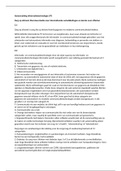Samenvatting
Geïntegreerde bedrijfseconomie: Samenvatting Strategic Management and Competitive Advantage
- Instelling
- Tilburg University (UVT)
Samenvatting van hoofdstuk 8 t/m 12 van het boek Strategic Management and Competitive Advantage door Barney & Hesterly (6th Edition), voor het tentamen van Geïntegreerde Bedrijfseconomie, gegeven op Tilburg University.
[Meer zien]














